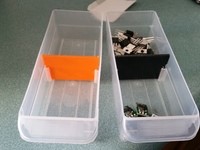If you would like to better control inventory, become more predictable and have what you need when you want it; you should implement Kanban into your processes.
First of all, the pronunciation is “Kon-Bon”, not “Can-Ban”. A kanban is a signal that informs the user that a part, necessary to complete a process, is running low and needs to be replenished.
Other names that you may have heard are 2-bin, order point, pull, supermarket, vendor managed, etc. These are all names of systems that are used to replenish items. I like the term Kanban because it is indeed a signal and implies the use of a simple visual that gives an immediate understanding of need.
An example of this simple signal is that of your low gas indicator in your car. Cars have both a gauge, plus an “idiot” light. This light brightens when you are running low on fuel to give you an immediate signal that you need to fill up, if you are not paying attention to the gauge. Some cars will even give you an estimate of the number of miles left before you need to walk to the nearest gas station.
This light is a Kanban, the signal that tells you to replenish the gas.
To set up a replenishment system and ensure that you have the amount of material necessary on hand, you need to determine a few items:
- Where should the Kanban be placed;
- How big should the inventory be;
- At what point do we signal the upstream process to produce more;
- How much should that upstream process produce; and
- What type of signal should be used to notify the upstream process.
Kanbans should be placed at critical points in the flow:
• Where supply time is greater than customer lead time
• Where spike demands cause lead times to extend
• Before divergent points, assembly points and bottlenecks
• After unpredictable operations
• Before and after long set ups
• Where continuous flow cannot be maintained

The size of the inventory level, the point at which the signal is delivered (Re-Order Point – ROP) and the amount to replenish (Re-Order Quantity – ROQ), is dependent upon the rate at which the item is consumed, the lead time to replenish the item and the constraints of the previous process. Typically, an analysis of the historical demand is completed, including the amount and frequency of consumption; as well as investigating how the upstream process operates. The recommendation is to standardize the ROQ, to be an appropriate quantity.
The signal to be used can be a number of things:
• Card
• Light signal
• Exchange of containers
• Empty space
• Shelves
• Bar code label
• Computer (work order / traveler)
The best signal is the simplest for the situation, that gives the previous process the accurate and timely information that they need.
A Kanban system that is properly set up and maintained, controls inventory while increasing turns, simplifies or eliminates the need to schedule, eliminates stock-outs and implements a standard predictable process.
If you have large uncontrolled inventory, expediting of processes, the wrong inventory on hand or unpredictability, you should investigate implementing a Kanban system.
Jim Johnson has more than 30 years of diverse manufacturing experience in engineering, project management, new product development and continuous improvement. Prior to joining Insyte, Jim held a variety of engineering positions at Greatbatch, Fisher-Price and General Motors. He is an active senior member of the Institute of Industrial Engineers. Jim is certified as a Professional Business Advisor through MEP University, is an ISO provisional lead auditor, and a trainer in lean manufacturing initiatives. He is on the Board of Advisors of RIT’s Industrial and Systems Engineering Department. Jim holds an MS in Industrial Engineering from the University at Buffalo and a BS in Industrial Engineering from RIT.


